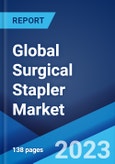The global surgical stapler market size reached US$ 4.2 Billion in 2022. Looking forward, the market is expected to reach US$ 6.5 Billion by 2028, exhibiting a growth rate (CAGR) of 7.55% during 2022-2028.
Surgical staplers are medical devices generally made using plastics or stainless steel and available in both disposable or reusable models. They assist in quick placement, strong wound closure, minimal tissue reaction, and low risk of infection. They also help in closing large wounds or incisions quickly in areas wherein the skin is tight. As a result, they are used as an alternative to sutures in minimally invasive surgeries. They are also utilized in operations to remove or reconnect parts of internal organs. Moreover, as they are strong, easy to use, and less painful than stitches, they are used to reduce the time of surgeries involving the digestive tract, including the esophagus, stomach, and intestines.
Reusable
Surgical staplers are medical devices generally made using plastics or stainless steel and available in both disposable or reusable models. They assist in quick placement, strong wound closure, minimal tissue reaction, and low risk of infection. They also help in closing large wounds or incisions quickly in areas wherein the skin is tight. As a result, they are used as an alternative to sutures in minimally invasive surgeries. They are also utilized in operations to remove or reconnect parts of internal organs. Moreover, as they are strong, easy to use, and less painful than stitches, they are used to reduce the time of surgeries involving the digestive tract, including the esophagus, stomach, and intestines.
Surgical Stapler Market Trends
The increasing number of individuals undergoing surgical procedures, along with the rising preference for minimally invasive (MI) procedures, represents one of the key factors bolstering the market growth. It can also be attributed to the increasing prevalence of obesity and acute and chronic diseases due to sedentary lifestyles, the escalating number of people who smoke and drink, and the increasing health consciousness among individuals. Moreover, the rising number of arthritis, cancer, and cardiovascular diseases in a significant part of the geriatric population is catalyzing the demand for surgeries across the globe. Apart from this, surgical staplers with implantable staples can be used in gynecologic, thoracic, gastrointestinal, and other surgeries. This, along with favorable reimbursement policies, is driving the market. Furthermore, the emerging trend of cosmetic surgeries among individuals to enhance their physical appearance, in confluence with the rising medical and cosmetic tourism, is acting as another growth-inducing factor creating a positive influence on the market.Key Market Segmentation
This research provides an analysis of the key trends in each sub-segment of the global surgical stapler market report, along with forecasts at the global, regional and country level from 2023-2028. The report has categorized the market based on type, product type, mechanism, application and end user.Reusable
Disposable
Breakup by Product Type:
- Linear Surgical Stapler
- Circular Surgical Stapler
- Cutter Stapler
- Skin Stapler
- Stapler Reload
Breakup by Mechanism:
- Manual Surgical Staplers
- Powered Surgical Staplers
Breakup by Application:
- Abdominal and Pelvic Surgery
- General Surgery
- Cardiac and Thoracic Surgery
- Orthopedic Surgery
Breakup by End User:
- Hospitals and Clinics
- Ambulatory Surgical Centers (ASCs)
Breakup by Region:
- North America
- United States
- Canada
- Asia-Pacific
- China
- Japan
- India
- South Korea
- Australia
- Indonesia
- Europe
- Germany
- France
- United Kingdom
- Italy
- Spain
- Russia
- Latin America
- Brazil
- Mexico
- Middle East and Africa
Competitive Landscape
The competitive landscape of the industry has also been examined along with the profiles of the key players being 3M Company, B. Braun Melsungen AG, CONMED Corporation, Frankenman International Ltd, Intuitive Surgical Inc., Johnson & Johnson, Medtronic plc., Meril Life Sciences Pvt. Ltd., Purple Surgical International, Smith & Nephew plc and Welfare Medical Ltd.Key Questions Answered in This Report:
- How has the global surgical stapler market performed so far and how will it perform in the coming years?
- What has been the impact of COVID-19 on the global surgical stapler market?
- What are the key regional markets?
- What is the breakup of the market based on the type?
- What is the breakup of the market based on the product type?
- What is the breakup of the market based on the mechanism?
- What is the breakup of the market based on the application?
- What is the breakup of the market based on the end user?
- What are the various stages in the value chain of the industry?
- What are the key driving factors and challenges in the industry?
- What is the structure of the global surgical stapler market and who are the key players?
- What is the degree of competition in the industry?
Table of Contents
1 Preface3 Executive Summary13 Value Chain Analysis15 Price Analysis
2 Scope and Methodology
4 Introduction
5 Global Surgical Stapler Market
6 Market Breakup by Type
7 Market Breakup by Product Type
8 Market Breakup by Mechanism
9 Market Breakup by Application
10 Market Breakup by End User
11 Market Breakup by Region
12 SWOT Analysis
14 Porters Five Forces Analysis
16 Competitive Landscape
Companies Mentioned
- 3M Company
- B. Braun Melsungen AG
- CONMED Corporation
- Frankenman International Ltd
- Intuitive Surgical Inc.
- Johnson & Johnson
- Medtronic plc.
- Meril Life Sciences Pvt. Ltd.
- Purple Surgical International
- Smith & Nephew plc
- Welfare Medical Ltd.
Methodology

LOADING...
Table Information
| Report Attribute | Details |
|---|---|
| No. of Pages | 138 |
| Published | November 2023 |
| Forecast Period | 2022 - 2028 |
| Estimated Market Value ( USD | $ 4.2 Billion |
| Forecasted Market Value ( USD | $ 6.5 Billion |
| Compound Annual Growth Rate | 7.6% |
| Regions Covered | Global |
| No. of Companies Mentioned | 11 |









